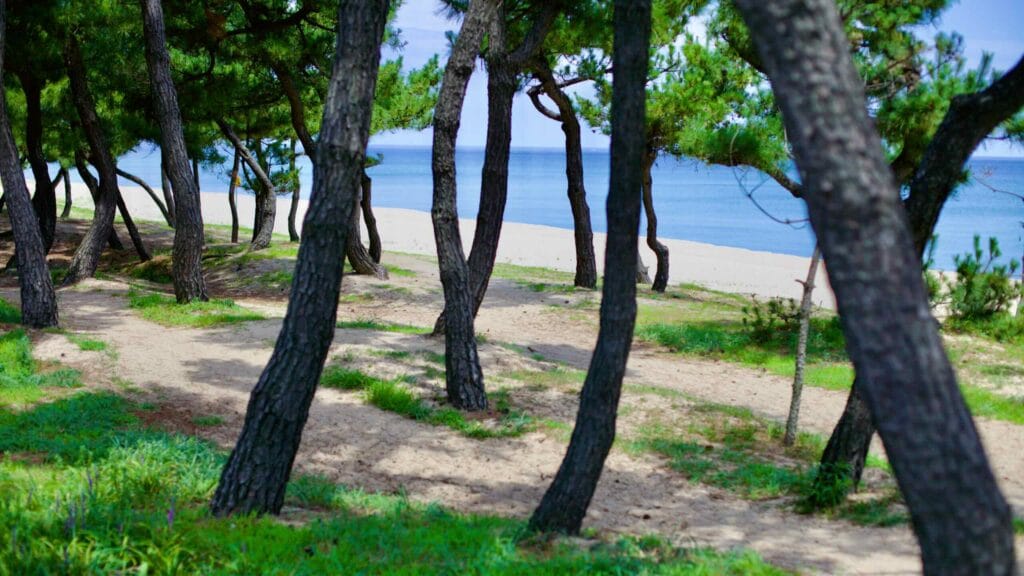
Yangyang County
Yangyang County (양양군; map), in Gangwon State, is a coastal region known for its natural beauty and historical sites. Seated midway up the Korean peninsula’s eastern coast, it’s surrounded by the East Sea and the Taebaek Mountains, offering a variety of natural vistas.
Yangyang’s history dates back to the Goguryeo Kingdom (고구려; 37 BCE ~ 668 ACE). Known as Ikhyeonhyeon in ancient times, the county is home to significant historical and cultural sites, including Naksan Temple, founded in 671 AD. Yangyang’s economy traditionally depended on fishing and agriculture, using its rich marine and forest resources. Today, it remains known for specialty products like pine mushrooms and salmon.
Presently, Yangyang County is a hub for nature enthusiasts and cultural tourists. It offers pristine environments, like Naksan Beach and Seoraksan National Park. These locations are ideal for activities like hiking, sunbathing and surfing, and cultural tours. Yangyang focuses on ecotourism, balancing natural preservation with tourism. It hosts events like the Pine Mushroom Festival and the Salmon Festival.
Coastal Yangyang
Life along the coast of Yangyang ebbs and flows with the sea. Most of the county’s population lives along the expansive 40.3 km coastline that borders the East Sea, which plays a critical role in local industries such as fishing and tourism.
The most prominent highlight along Yangyang’s coast is Naksan Temple, a spiritual haven with 1,500 years of history. Nestled against the backdrop of Nak Mountain (낙산; map), the temple’s serenity and sea views encapsulate the area’s spiritual and natural harmony. Other notable landmarks along the county’s coast include Jukdo Mountain, Hajodae Pavilion, and Huyuam Temple.
Yangyang Ports
Yangyang’s ports help feed the country’s economy and people. Though they are not as large or famed as Sokcho’s harbors in the north, they support local traditions and offer fresh seafood cuisine.
- Namae Port (남애항; map): As one of the three most beautiful ports in Gangwon State, Namae Port is famous for its Skywalk Observatory. The port provides stunning sunrise views and is a hub for local fishing activities.
- Mulchi Port (물치항; map): Seated in Mulchi Village, the port is Yangyang’s northernmost port, near Seoraksan Mountain. Known for its unique lighthouses shaped like pine mushrooms, it offers picturesque sunrise views and is popular for water sports and beach camping.
- Gisamun Port (기사문항; map): Near the 38th Parallel, Gisamun Port, designated in 2007, has a history rooted in pollack fishing. Today, it’s known for squid, anchovies, flounder, and octopus. The port offers pier fishing and fresh seafood in a tranquil setting.
Food
Yangyang County is celebrated for its diverse culinary landscape. Here is a unique array of local specialties that span from the county’s mountains to its sea:
- Yangyang Beef (양양한우): Grazing near Seoraksan Mountain and the East Sea, Yangyang cows are renowned for the quality of their meat. The beef, raised in ideal conditions, is a testament to Yangyang’s commitment to superior food production.
- Mountain Vegetable Dishes (산채요리): Highlighting the region’s mountainous terrain. These dishes feature wild greens and herbs from Seoraksan. Served with minimal seasoning, they offer an authentic taste of natural mountain produce.
- Spicy Mussel Noodle Soup (홍합장칼국수): This warming dish blends East Sea mussels with homemade spicy broth, known for satisfying fishermen after long days at sea.
- Cold Raw Fish Noodle Soup (회냉면): Yangyang’s unique take on this dish uses potato starch noodles, typically served with flounder sashimi, marrying mountain and sea flavors.
- Fusion Salmon Dishes (퓨전연어요리): Modern takes on salmon, including steaks, cutlets, and sushi, rich in Omega-3 fatty acids and perfect for health-conscious diners.
- Pine Mushroom Dishes (송이요리): Using local pine mushrooms, these dishes range from hot pots to stone pot rice, offering a unique experience.
- Buckwheat Noodles (메밀국수): A Gangwon State classic, these noodles are served chilled or with a spicy sauce, accompanied by well-cooked pork for a nutritious meal.
- Raw Fish Slices (생선회): Fresh seafood from the East Sea served as various types of sashimi, reflecting the region’s rich marine resources.
- Freshwater Fish Soup (뚜거리탕): Made with “ttugeori,” a local freshwater fish from Namdae Stream, this soup is a beloved comfort food in autumn.
- Mussel Soup (섭국): A distinct local soup made with East Sea mussels, known for its restorative properties and rich proteins.
- Hamburgers (양양 햄버거): A hit among Yangyang’s surfing community. These burgers offer a satisfying meal after a day of surfing.
Yangyang County may not be a major population center, but it’s renowned for its diverse landscapes and rich cultural heritage. The “Ten Views of Yangyang” offers visitors a unique journey through its natural beauty and historical significance:
- Namdae Stream (남대천; map): A tranquil stream flowing through the county, Namdae Stream is a favorite for leisure activities. Its clear waters and picturesque surroundings make it great for walks and picnics.
- Daecheong Peak (대청봉; map): Dominating the skyline above Yangyang, Daecheong Peak in Seoraksan National Park offers stunning vistas and diverse flora and fauna.
- Five Colors of Hangye Mountain Pass (오색령 한계령); map): This mountain pass, spectacular in autumn, provides access to Seoraksan National Park. It’s known for its vibrant fall colors, attracting nature enthusiasts and photographers.
- Five Colors Jujeon Valley (오색주전골; map): A valley with crystal-clear streams perfect for hiking, Jujeon Valley is a serene escape surrounded by lush greenery that changes with every season.
- Hajodae Pavilion (하조대; map): A coastal locale with high cliffs and expansive sea views, the pavilion is a favored spot for sunrise and sunset viewing.
- Jukdo Pavilion (죽도정; map): Perched on Jukdo Mountain, the pavilion provides coastal panoramas.
- Namae Port (남애항; map): An active fishing port offering a glimpse into local life. Namae Port offers vibrant fish markets and freshly caught seafood.
- Naksan Temple (Naksansa; 낙산사; map): A historic Buddhist temple near the coast, Naksan Temple offers a peaceful retreat. It’s a site of spiritual importance and architectural beauty, rich in tradition.
- Osan Village Museum of Prehistoric Relics (오산리선사유적박물관; map): This museum showcases artifacts from Yangyang’s prehistoric sites, providing insights into the region’s ancient history and cultural development.
- Yangyang Surfing Road (양양 서핑로드; map): A popular destination for surfers of all levels, Yangyang Surfing Road crosses Jukdo Beach, Ingu Beach, and Hajodae Beach, which sport surfboard renters and schools. The region has become a hub for Korea’s surf culture.
Inland Yangyang
Inland Yangyang, distinct from its coastal counterpart, offers a rich tapestry of mountainous terrains and history.
Seoraksan National Park forms the centerpiece of Yangyang’s western region. The park is a breathtaking expanse of rugged and serene mountains. It offers a diverse array of hiking trails catering to various levels of expertise and interest.
Seorak Mountain (설악산; Seoraksan) itself is a significant part of the Taebaek Mountain Range. Renowned for its striking natural beauty, it is characterized by rugged peaks, dense forests, and diverse wildlife and designated by UNESCO as a Biosphere Protection Site. The mountain is also steeped in history and spirituality, with ancient temples like Sinheungsa in Sokcho City.
Yangyang County, the prized Songi mushrooms (송이), are a national delicacy. These pine mushrooms, known for their exceptional quality, fetch premium prices, with Grade 1 Songi reaching ₩822,500 ($615) per kilogram at auction. Celebrated for their robust aroma and firm texture, only Yangyang’s pine forests provide the ideal conditions to grow Songi mushrooms. The annual Yangyang Songi Festival celebrates this local treasure. It offers visitors and locals the chance to forage for the mushrooms and try them in various dishes, from traditional stews to modern fusion cuisine.




